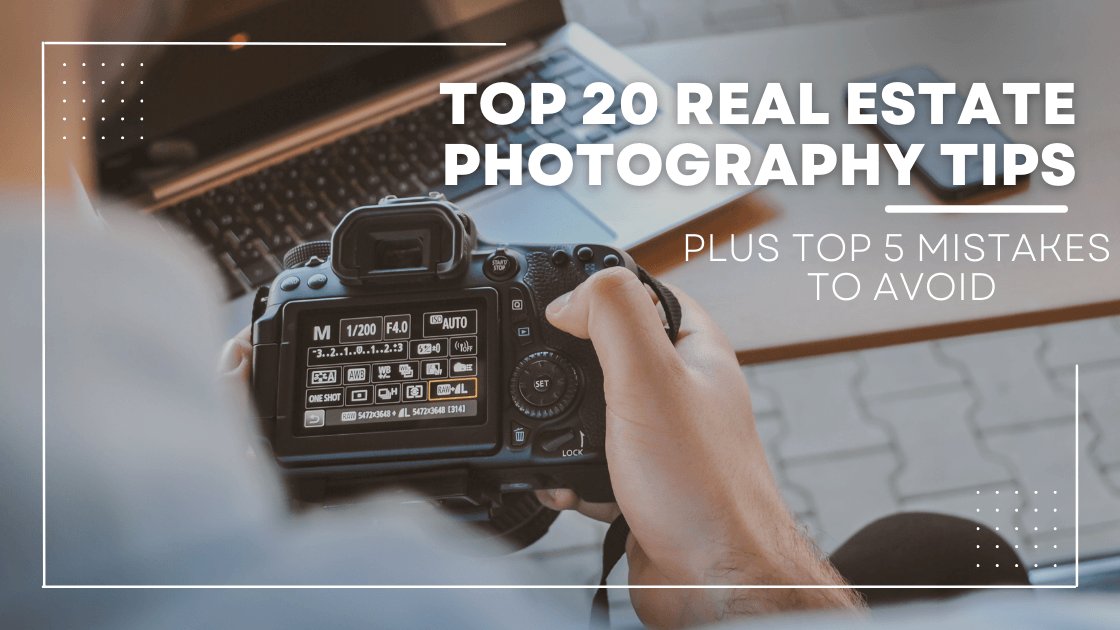Are you a real estate photographer looking to take your business to the next level?
If so, you’ll want to read our post on the top 20 real estate photography tips.
Plus, we’ve also included the top 5 common mistakes to avoid as a real estate photographer so you can make sure your photos are perfect every time!
Page Contents
Top 20 real estate photography tips
1. remove needless objects
Nothing turns off customers faster than dirty property photos. Asking your client to clean up before taking your real estate photos is an easy way to make your photos look more professional. Having the property thoroughly cleaned before the photoshoot is a crucial real estate photography tip.
Ask the owner to clean the interior and exterior of the home, including sweeping away any debris or clutter, washing windows (inside and out), dusting furniture, raking fallen leaves (or snow), and de-cluttering the yard/landscape area, etc.
2. Move furniture to capture more space
Clear distractions from your shot – everything within your frame should support your story about what makes this property stand out. For example, you can move your furniture to capture more space instead.
If there are distracting objects in the foreground or background that don’t contribute to that story, remove them by either setting up a separate shot for them or cropping it off later.
3. Edit Photos but don’t go overboard
When editing your photos, make sure you capture only the property’s highlights. Keep it simple, and don’t go overboard with editing.
Your photos should answer how a buyer would experience this home in person? What are their first impressions? What questions would they want to be answered?
4. emphasize the best feature in each room
The point of view you use will depend on what you want to highlight or leave for potential buyers to explore themselves. You should also consider which room presents the best “sell” for the home and how close to get to it.
For example, if it’s a small master bedroom, shoot from head-on with the door closed, so it looks larger than life! You can do this by getting down on the floor shooting upwards at the ceiling with a wide-angle lens.
5. Play with different lenses
The fish-eye lens is all about distortion, which gives you some wiggle room when choosing your point of view for an otherwise unappealing shot. Instead, it turns straight lines into curves and exaggerates both sizes and shapes.
Investing in one is not necessary to produce beautiful real estate photos but can be helpful when trying to find that perfect “wow” shot!
6. find your focus
Every photo should highlight a different part of the house. By reducing your depth of field (blurred out foreground/background) you can emphasize a certain aspect in the foreground. This can be done by lowering the f-stop on your camera.
You can use this technique to emphasize or deemphasize items within your shot, depending on what you want buyers’ attention to be drawn to the most.
7. take practice photos to prefect the proper angles
Experiment with different angles, points of view, and depths of field. Don’t just take photos from head-on; walk around the property and see if there’s a better way to capture it than simply standing at eye level (i.e., shoot down at an angle for an interesting perspective).
Also, keep in mind that every room has multiple points of view, so explore them all. Sometimes you’ll find something cool that wasn’t obvious at first glance.
8. plan around the light
The light during the day constantly changes, so it’s worth taking photos at different times throughout the day.
Real estate photography revolves around the use of light. If possible, shoot when the sun is positioned in a way that minimizes shadows or other problems within your shot. Shoot when the sun in the sky is low for dramatic lighting, etc.
Another option is to shoot during dusk or dawn, which provides soft, even light that you can’t get any other time of day. The warm glow makes all your colors look more affluent and more saturated while also making everything feel cozy – perfect for selling homes!
9. Think like a buyer
It’s critical to put yourself in the shoes of the audience. If real estate photography aims to help buyers visualize themselves in the space, consider how each room is displayed.
This means that in a kitchen, where people are generally standing to make food, you should photograph from a higher angle, and in a dining room, where people are normally seated, you should film from a lower angle.
One tip is to use a tripod to increase the height of your camera to fit enormous furniture, significant features, or elements that are meant to be hidden.
Countertops and stools, for example, are frequently extremely high. You may need to lift your tripod because the goal is to capture the upper side of surfaces.
10. compose your pictures to emphasize space & natural light
Using your windows as light sources can have interesting results – it will produce natural-looking shadows and reflections that really bring out textures in the scene.
It works best if there’s something interesting outside for those details to reflect on. This trick can be used indoors as well but will depend on how much ambient light comes through the window or door that leads outside.
You want just enough to show what’s outside without being distracting from the subject of your photo being inside.
11. Dedicate several hours for your photoshoot
Never just shoot one shot. You may have to shoot dozens of different images before finding one or two gems. You should account for this and give yourself plenty of time to get the shots you want. You might even have to spend several days shooting one location. As frustrating as this might be, it’ll be worth it in the long run.
12. Correct lens distortion if needed
Another way you can make use of distortion is by emphasizing patterns within your shot.
If there are items within the scene with repetitive lines/shapes, consider shooting them in an angle that emphasizes those patterns instead of head-on.
This technique draws the eye to the part of the photo you want buyers to notice first.
13. use preset editing
It takes a lot of time and effort to edit after a shoot, so always shoot with post-editing in mind.
This means taking photos for your computer instead of your camera – by prepping ahead of time, you can save yourself from editing headaches later on! Also, remember that less is more when it comes to editing.
Be as minimal as possible unless it’s absolutely necessary because clients will often prefer simple/natural shots over photoshopped ones every time.
14. experiment with angles
There’s no such thing as a “bad” angle, only angles that give a different perspective on the room. This is for both interior and exterior real estate photography tips.
Getting up close and personal with your shots will make them feel more intimate and give viewers a sense of what it’s like to be in that room.
15. set proper camera settings to keep the quality images
Good lighting is required for real estate photography.
If you don’t have or don’t know how to use special lighting equipment, consider these real estate photography camera settings to maintain the quality of your images high.
The aperture should be between f/7.1 and f/9. A small depth of field can be used to highlight specific objects.
Normally, the shutter speed should be between 1/60 and 1/2 second. The amount of light in the room determines this rating.
16. Optimize angles
Explore what different angles will do for your shot without moving your subject. For example, you might find some unexpected results that are more visually interesting than the ones you had originally envisioned! Angle changes are one of the quickest ways to spice up a photo without too much effort.
17. Take care of iSO settings to eliminate noise
As a real estate photographer, you understand the importance of quality images.
However, if your ISO for real estate photography settings is not correct, you could have noisy images that distract from your work. Instead, you have to take care of your ISO settings to avoid noise and produce stunning photos.
Keep in mind that using an ISO setting that is too high can result in a lot of digital noise in your images. Attempt to keep the ISO below 400.
18. draw blinds apart to let in more light
Another important Real estate photography lighting tip is to make proper use of the sun as a natural source of light. The sun can be a great source of light but can also make windows look like they’re reflecting more light than they are.
If you have windows or glass doors in your shot, pay attention to the light levels. You might end up with photos where this becomes distracting. To avoid this, draw blinds apart to let in more light.
19. Do a walk through before shooting
It may seem obvious since you’re probably not purposely trying to take bad photos, but sometimes we forget that our surroundings impact the way our pictures turn out. One of the most common things that can go wrong is missing or misplacing an object in your photo.
Avoid this by being aware of your surroundings and doing a walkthrough, thinking ahead to what you’re going to shoot before you even begin photographing.
20. get wide-angle lenses to cover the maximum space
A 24mm lens would be considered “regular” or “standard.” It’s roughly equivalent to the field of view we see with our eyes — about 35mm full-frame equivalent on today’s cameras which have smaller sensors than their 35mm film predecessors.
Most DSLRs come with a zoom lens in the 18-55mm range (28-80mm full-frame equivalent) which is excellent for documentaries but not wide enough to be considered ultra-wide.
We also have a checklist for real estate photography. Check it out!
top 5 real-estate photography mistakes to avoid
Here are the 5 real-estate photography mistakes you should avoid as a professional photographer.
1. not having an edit policy
When shooting for a real estate agent, you must understand that the images will be used in multiple ways. To see your images in various layouts and variations, you need to edit them accordingly.
This is why you must create an edit policy before starting a project with a client. If this hasn’t been discussed beforehand, there’s a chance that your client might not approve of specific edits after receiving the final product, which means either going back and editing things again or losing out on some money.
It’s best to avoid all these headaches by having an edit policy ready ahead of time.
2. Using bad equipment
Of course, the price of your camera isn’t going to immediately change if you find out that you don’t have the best equipment for this job.
But it’s still something to consider because image quality can be directly affected by the gear you use. For example, having a high-end DSLR or Mirrorless camera with superb optics is essential if you want the client to truly appreciate all of your hard work.
3. Using inaccurate data
The old saying “fail to prepare, prepare to fail” applies here more than in any other industry. There are so many small details that need to be discussed before the shoot even begins, so proper planning ahead of time is essential.
4. Using Too Many Post-processing Tools
Remember that it’s always best to get your shot right during the first capture, so don’t fall into over-processing.
Sure, you should try different styles and processing techniques but make sure there is a point to each effect, not just because you can.
5. Not Understanding Your Client’s Needs
Knowing your client’s requirements and needs before starting a shoot is very important; spend some time setting expectations by closely communicating with them.
A few weeks before the actual shoot, do a walkthrough at the location, meet the homeowners and familiarize yourself with their style and taste in furniture, decor, lighting, etc.
Finally,
It’s essential to have great images of your property if you want to sell it quickly and reasonably.
The top 20 real estate photography tips & tricks we’ve shared will help you take amazing photos that show off your property in the best light possible. But before you start snapping away, make sure to avoid the common photography mistakes!
You can also book our professional real estate photography team and sell your property fast without mistakes and hassle. Revepix provides stunning interior and exterior photos as part of our real estate photography service.



